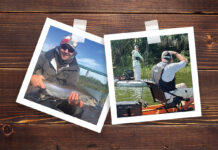Fishermen are famous liars. For the sake of a good fish story, we’ll stretch a fish a few inches or add a few pounds. But when tournament pro Andrew Shepherd was accused of using an altered measuring device to add a few inches to his catch and win thousands of dollars, no one was laughing. So, how did it happen? What are tournament organizers doing to keep competitive fishing fair?
Most kayak fishing tournaments use a catch, photo and release format. When the angler makes a qualifying catch, he photographs the fish along with a date marker on a measuring device and then releases the fish and submits the photo as proof of his catch. The system works great, but it relies on angler honesty. With more tournaments offering cash payouts, tournament directors are working hard to prevent, detect and punish cheating.
Kayak Bass Fishing (KBF), one of the longest-running kayak fishing tournament trails, has systems and procedures in place to detect cheaters. “Our system is bulletproof,” tournament president Chad Hoover explains. “Our rules are designed to teach anglers how to compete ethically.” Working with a panel of anglers and directors, KBF has developed rules and procedures to deal with unethical behavior. “We require all tournaments in our series to use our rules,” he says, “and tournaments outside our series are adopting our system.”
One of those tournaments is Kayak Bass Series (KBS), where a cheater was caught by tournament director Andrew Cameron. “I couldn’t believe it,” Cameron recalls, “I double-checked and triple-checked when I first noticed discrepancies in his photos.” After Cameron blew the whistle, he started to review the tournament’s rules and procedures. “We’ll adopt KBF rules to help align ourselves with a single set of rules for all tournaments,” Cameron says.
Many tournaments use smartphone applications to submit photos and catch info. Tournament directors are working with software developers to create a virtual ruler that can be used to verify the authenticity of the angler’s measuring device. “People travel from all over the country and spend thousands of dollars to participate in our events,” Cameron says. “It’s up to us to keep it straight.”
Recently, Hoover decided to change KBF rules to allow tournament organizers to publicly identify cheaters. “Previously we had banned cheaters from future tournaments but we couldn’t publicize their names,” Hoover explains. Now anglers can be identified. “Outing cheaters is an important step in preventing cheating,” Hoover says.
The upside is more integrity in tournaments, both Hoover and Cameron look at the silver lining. “We’re closing loopholes and making our systems easier to use,” Hoover says. Cameron adds, “We’re still working on feedback from anglers, but once our system hits the big table anglers will think twice before altering the length of their fish.”

 This article was first published in the Winter 2016 issue of Kayak Angler Magazine.
This article was first published in the Winter 2016 issue of Kayak Angler Magazine. 




